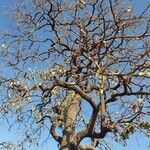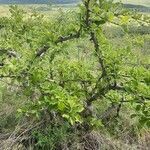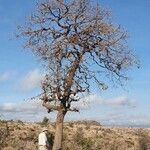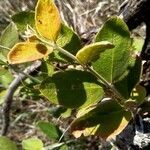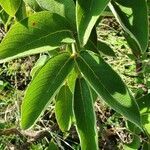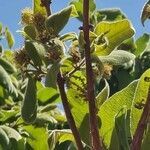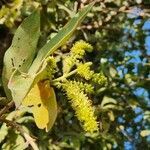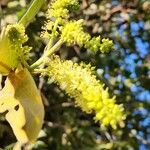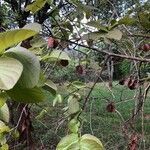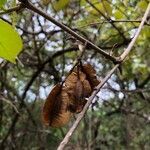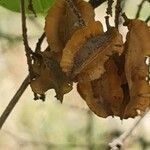Leaves opposite; lamina up to 14(16) x 9 cm., narrowly elliptic or narrowly ovate-elliptic or obovate or obovate-elliptic, typically densely grey-tomentose (often drying dark-velvety-brown) but almost glabrous in some forms, lepidote but scales often hidden by the indumentum, reticulation usually very prominent beneath (but less so in some apparently transitional forms), apex acute or obtuse and often mucronate or apiculate, base usually rounded to subcordate; lateral nerves 6–12 pairs; petiole usually 2–3 mm. long (up to 9 mm.) leaving after leaf-fall rather prominent circular projections on the stem.
Semideciduous tree or shrub, up to 10 m high. Bark of young branchlets coming off in untidy irregular fibrous strips or threads. Leaves opposite; blade narrowly to broadly elliptic, occasionally broadly obovate, 60-170 x 40-110 mm, apex acute, densely greyish tomentose, net-veining prominent on lower surface, veins distinctly sunken above. Flowers: in axillary spikes; corolla yellow or greenish yellow; Aug.-Nov., Feb. Fruit 4-winged, 15-20 mm long, yellowish green flushed red, drying to golden reddish brown.
Scales ± contiguous on the areolae of the lower surface of the leaf, c. 75(90)–120(130)µ in diam., ± circular with marginal cells usually concave, usually with 8 radial walls and typically 8 (rarely 0) tangential walls and sometimes with many to several extra radial walls; marginal cells 8–11(16); cell-walls clear and usually very thick; cells usually opaque.
A shrub or small tree. It grows 10 m high. The leaves are oval and 11 cm long by 7 cm wide. They are rusty velvet on both surfaces. The flowers often appear before the leaves. The flowers can occur singly or in clusters in the axils of the leaves. The fruit are 2 cm long and 1.5 cm wide. They have gland dots over them.
Fruit 1·5–2(2·5) x 1·5–2(2·5) cm., subcircular to elliptic in outline, lepidote and tomentose (especially on the body) to nearly glabrous (except for scales), apical peg up to 1 mm. long (often much shorter), wings 5–7 mm. broad, stipe 2–3(5) mm. long.
Semi-deciduous tree usually up to 8(17) m. high or shrub; crown rounded to flat-rounded; bark black-brown to grey-brown, rough, fissured; branchlets tomentose to almost glabrous with bark coming off in fibrous strips.
Semideciduous tree or shrub, up to 10 m high. Bark of young branchlets coming off in untidy irregular fibrous strips or threads. Leaves densely grey-tomentose. Fruit 20 mm long. Flowers yellow or greenish yellow.
Inflorescences of axillary spikes up to 7(11) cm. long occasionally forming panicles by suppression of the upper leaves; rhachis tomentose; bracts 1–2 mm. long, filiform, caducous; peduncles 1–2 cm. long.
Cotyledons 2, 2·5 x 2·5–3·5 cm., subcircular to transversely elliptic, arising at or below soil level; petioles 3·5–4 cm. long.
Petals 0·5–1 x 0·5–1 mm., sometimes minute or absent, irregularly obovate-deltate to reniform, ciliate at the apex.
Lower receptacle 1·5–2 mm. long, tomentose; upper receptacle 1·3–3 x 2–3 mm., campanulate, tomentose.
Stamen-filaments 5–6 mm. long, inserted at the edge of the disk; anthers 1 mm. long.
Savannah tree with relatively straight bole, to 30 ft. (rarely to 50 ft.) high
Disk with a very short pilose free margin less than 0·5 mm. long.
Characteristic dark grey deeply fissured bark
Style 5 mm. long, not expanded at the apex.
Flowers sessile, yellow or greenish-yellow.
Sepals 0·5–1 mm. long, broadly deltate.
Petals and stamens cream.
